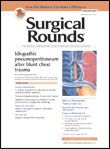Publication
Article
Surgical Rounds®
Adhesion Incidence and Severity Vary by Surgical Procedure
Author(s):
Many adhesions are asymptomatic, but in some patients, they can cause pain, small bowel obstruction and other postoperative issues, as well as increase cost and complicate surgical suite workload.

Experts estimate approximately 93% of patients who have undergone laparoscopic surgery develop abnormal fibroid bands that bind organ surfaces to the abdominal wall after a second surgery. Many adhesions are asymptomatic, but in some patients, they can cause pain, small bowel obstruction and other postoperative issues, as well as increase cost and complicate surgical suite workload.
As surgeons underestimate the rate of adhesion development given that up to 93% of consent forms don’t address them, the March 2014 issue of Surgery Today contained a systematic review estimating the formation rate, distribution, and severity of postoperative adhesions in abdominal surgery patients.
After reviewing 25 studies published between January 1990 and July 2011, the authors determined the weighted mean formation rate of adhesions after abdominal surgery was 54%. However, different types of surgeries and procedures had different adhesion statistics. Among patients who had gastrointestinal (GI) surgery, 66% developed adhesions. In patients who had gynecologic and urologic surgeries, the rates were 51% and 22%, respectively.
Since those rates were lower than the numbers reported a few decades ago, the authors suggested current practices such as minimizing peritoneal foreign body exposure, careful tissue handling, meticulous hemostasis, specific closure of the peritoneum in caesarean sections, and modern surgical techniques have helped reduce the rate of adhesion.
The authors reported laparoscopic surgery reduced the adhesion formation rate by 25% and also decreased the adhesion severity score for Gl surgery. They concluded heightening awareness of adhesions is needed to shed light on the complication’s etiology.
With better understanding of how and why adhesions form, researchers will be able to develop novel therapeutic approaches, the authors said. They also suggested the potential for adhesions should be addressed clearly in consent forms.






